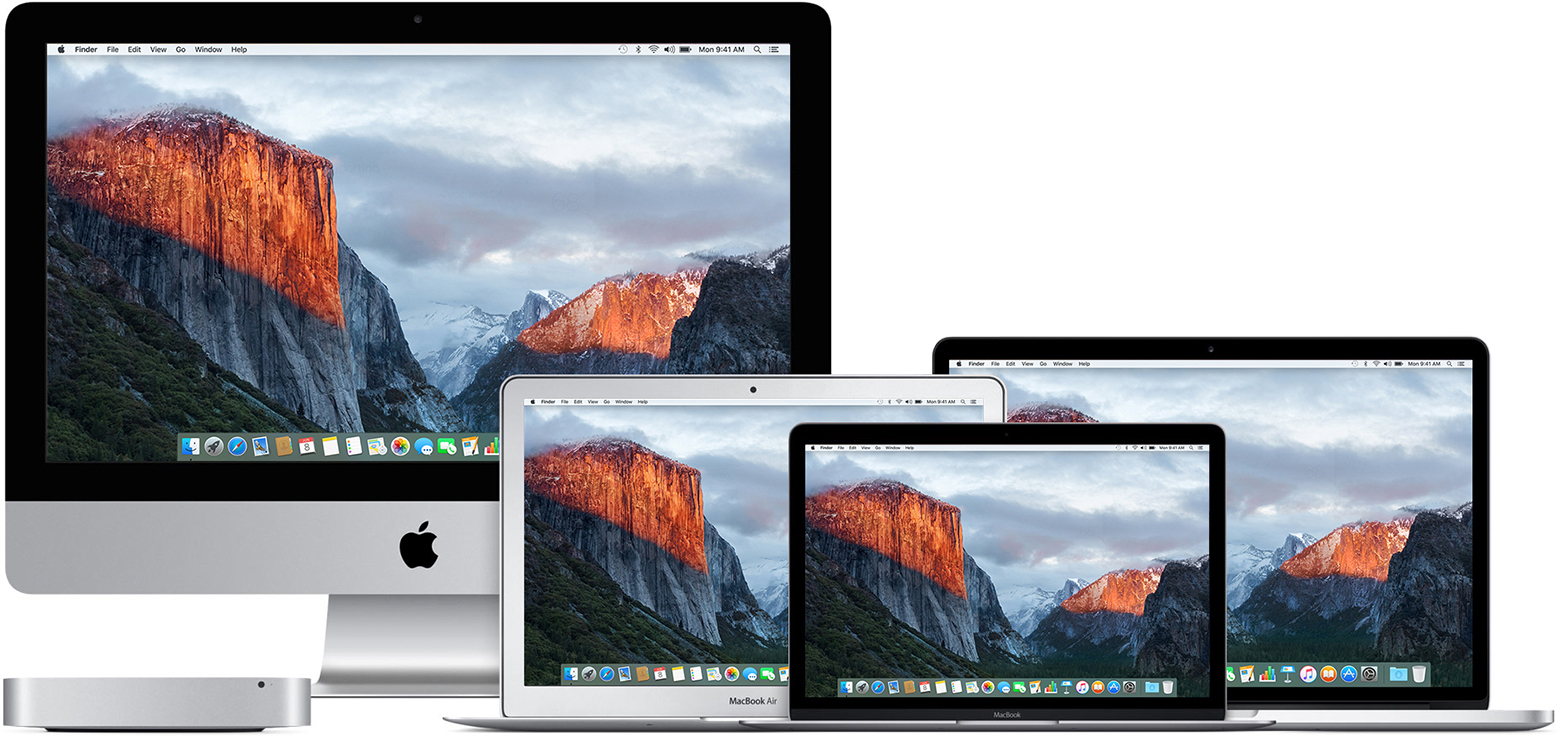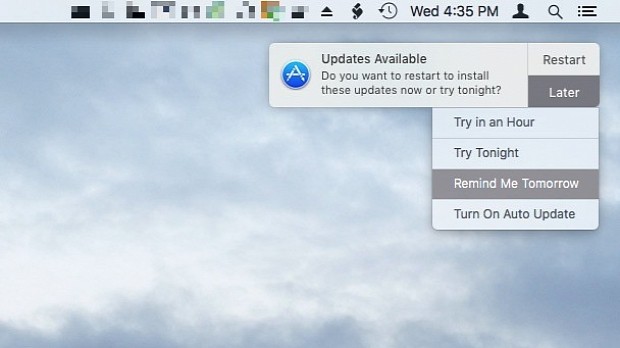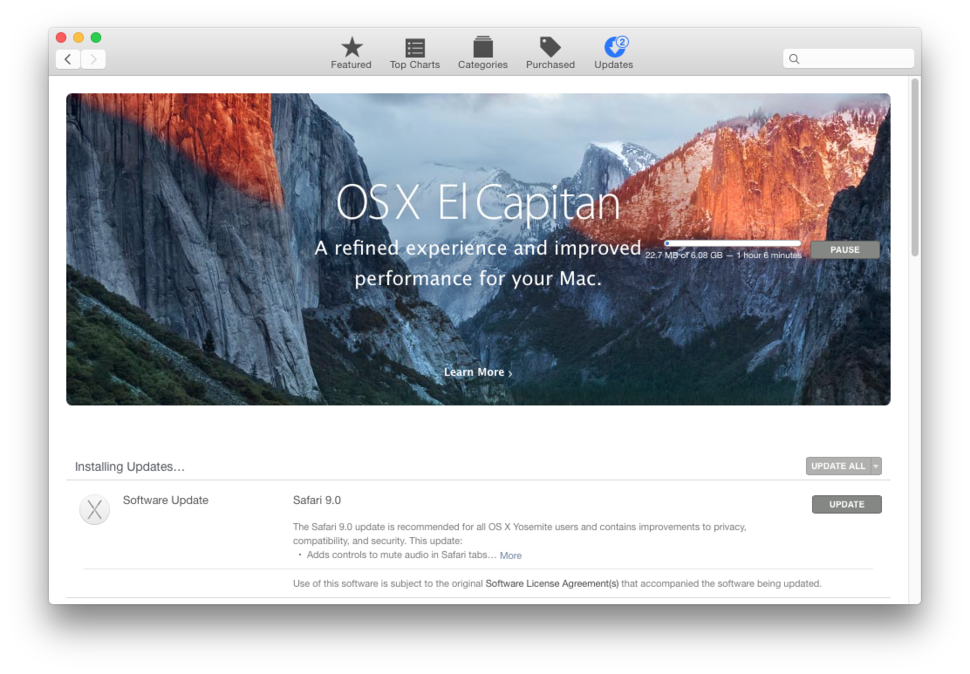Software Update El Capitan
Jul 18, 2016 The OS X El Capitan v10.11.6 Update improves the stability, compatibility, and security of your Mac, and is recommended for all users. This update: Resolves an issue that may prevent settings from being saved in accounts with parental controls enabled. Resolves an issue that prevented some network devices, such as speakers and multifunction printers, from accessing SMB share points.
- You can upgrade your 10.11.6 (El Capitan) directly to Sierra (10.12.2) by going to the AppStore and downloading it. It is always best to upgrade unless you have Applications that will not run in Sierra. Your standard Apple apps should run fine. You can check others here: Here is an Apple Support Topic on upgrading to Sierra.
- The simplest way to update OS X to 10.11.5 is through the Mac App Store: Back up the Mac before beginning, with Time Machine or your backup method of choice. Open the Apple menu and go to “App Store”. Under the “Updates” tab you will find the “OS X El Capitan Update 10.11.5” available to download. The Mac must reboot to complete.
Although new versions of iTunes have not been released for macOS since May 2019, compatibility with new iOS releases (iOS 13, 14) have been backported to iTunes 12.8.2 (for OS X 10.11 El Capitan, macOS 10.12 Sierra, 10.13 High Sierra) and 12.9.5 (for macOS 10.14 Mojave). Apple Newsroom is the source for news about Apple. Read press releases, get updates, watch video and download images. El Capitan rises above the El Capitan bridge Trail Overview. Distance: 11.5 mi (18.5 km) full loop; 7.2 mi (11.6 km) half loop Elevation gain: Mostly level Difficulty: Moderate Time: 5-7 hours full loop, 2.5-3.5 hours half loop Begin at: Lower Yosemite Fall (shuttle stop #6) head west along the bicycle path until you see signs for the Valley. Two-factor authentication is an extra layer of security for your Apple ID designed to ensure that you're the only person who can access your account, even if someone knows your password.
Trail Overview
Distance: 11.5 mi (18.5 km) full loop; 7.2 mi (11.6 km) half loop
Elevation gain: Mostly level
Difficulty: Moderate
Time: 5-7 hours full loop, 2.5-3.5 hours half loop
Begin at: Lower Yosemite Fall (shuttle stop #6) [head west along the bicycle path until you see signs for the Valley Loop Trail]
This trail follows many of the Valley's first east-west trails and wagon roads. It offers a rare opportunity in Yosemite Valley: to hike on a fairly level trail with some solitude. While some of the trail passes near roads, much of it takes you through meadows, talus slopes at the base of the granite cliffs, and near the Merced River. You can access the trail from many places throughout the Valley; however, the mileage and description used here starts at the Lower Yosemite Fall area (follow signs for Valley Loop Trail). Route-finding can be difficult in places, so it is best to bring a map with you (even a simple day hiking brochure from the visitor center) as it will orient you with the various landforms in the Valley, which are often listed on the trail/directional signs.
From the Lower Yosemite Fall area, head west along the base of the Three Brothers rock formation, past Camp 4, eventually working your way through Yosemite Valley to El Capitan. If you are planning to hike the half loop, cross the Merced River at El Capitan Bridge and continue by heading east back toward Yosemite Village. If you are planning to hike the full loop, continue west past El Capitan toward Bridalveil Fall. While most of the trail is flat, there are some hilly sections throughout the hike. Additionally, you will find mixed trail surfaces: dirt, rocks, sand, and old pavement.
Seasonality
The Valley Loop Trail is open year-round. During spring, you may find localized flooding on the trail near creeks. During winter, the trail is often snowy and icy in places, particularly along the south side of Yosemite Valley. In these areas, use extreme caution as it may be hard to get traction on ice and route-finding may be difficult in snowy areas (the trail may be completely obscured by just a few inches of snow).
Itunes El Capitan
Some devices that use older software can no longer use the iTunes Store
Because of increased security, some devices that use older software can no longer use the iTunes Store.
Apple recommends that you update your software in the following situations:
Itunes El Capitan Download
- If you see error -9836
- If you have trouble loading the iTunes Store
- If you can’t edit your payment method in the App Store or iTunes Store
- If you have trouble buying items in the App Store or iTunes Store
- If you have trouble redownloading items from the iTunes Store on your Windows PC
Update your software
- On your Mac, install the latest version of macOS. If you can't install the latest version of macOS, try to install OS X El Capitan 10.11.
- On your Windows PC, install the latest version of Windows and download the latest version of iTunes.
- Update your iPhone, iPad, or iPod touch to the latest version of iOS or iPadOS.
- Update your Apple TV to the latest version of tvOS.
Some obsolete hardware products can no longer use the iTunes Store
Itunes El Capitan Ios 13
If your device is obsolete, you might not be able to use the iTunes Store on that device, even if you update the software. See if your device is listed as obsolete.
Jul 05, 2021 • Filed to: Solve Mac Problems • Proven solutions
Mac users get new software updates and versions more frequently than the other operating systems. That's both the blessing and curse for the Mac users. The latest software makes your Mac device compatible with the new technological developments. Still, it also makes the existing OS obsolete. That's why most Mac users with old devices try to update their Mac to OS X El Capitan. However, you can't update your Mac to El Capitan 10.11 if your Mac runs on software later than Mac OS X 10.6 Snow Leopard.
Is OS X El Capitan Still Available for Your Mac?
OS X El Capitan (10.11) was launched on 25 September 2015, and it is an improved version of OS X Yosemite (10.10). Improved window management, quick and responsive interface, spotlight search, and enhanced graphics were the prerequisites of El Capitan OS. However, if you are planning to update your Mac to OS X El Capitan, your device must fulfill the following requirements.
Space Requirements
You can't install OS X El Capitan unless your Mac has a free space of 8.8 GB. However, that's the space you need to install El Capitan on your Mac. You might have to free more space to run your Mac more smoothly because low space slows down system performance.
Hardware Compatibility
Most of the Mac models can install and run OS X El Capitan, but in some devices, you can't use full features of this OS due to hardware limitations. For instance, you can't use AirDrop on your Mac if you don't have a WiFi network compatible with PAN. The followings are devices that are compatible with OS X El Capitan.

- MacBook introduced in 2009 or later, plus MacBook (13-inch, Aluminum, Late 2008)
- MacBook Air introduced in late 2008 or later
- MacBook Pro introduced in mid-2007 or later
- Mac mini introduced in early 2009 or later
- iMac introduced in mid-2007 or later
- Mac Pro introduced in early 2008 or later
- Xserve models introduced in early 2009
RAM Compatibility
RAM is the temporary memory that supports the system to run apps and programs efficiently. Without enough RAM, trust me, you can't even run your native operating system smoothly. Similarly, you can't install El Capitan unless you have 2 GB RAM on your Mac.
Operating System Compatibility
Operating systems play a critical role in creating an operational environment for both the software and the hardware. If you have decided to update your Mac PC, you have to make sure that your device doesn't run the OS later than Mac OS X Snow Leopard 10. 6. 8.

People Also Search:
How to Update My Mac to OS X 10.11.6/10.11.4?
After you are done with checking the compatibility of your Mac device, it's time to follow some pre rituals to prepare your device for Mac OS X El Capitan 10.11. These steps are mandatory for the successful installation of El Capitan OS into your Mac, and Apple also suggests them.
Get Your Mac Ready for El Capitan Update
Unprepared installation of a new operating system can result in disappointment. Remember that you are going to get a relatively new OS for your older Mac. To increase the hardware compatibility of your Mac, you must go through a checklist for successful installation of OS X El Capitan.
Space in your Mac: This includes freeing space both on RAM and Disk drive. 2 GB RAM and 8.8 GB of disk space are mandatory because the installer would not proceed without the fulfillment of these hardware requirements.
Minimum battery requirement: During the OS update, a computer consumes battery quicker than the regular operations. Your Mac needs to have at least 45% battery to pass through the El Capitan installation.
Active Internet Connection: You can't proceed with any OS installation without an active internet connection. Along with the installation package, your Mac would also need some side installations throughout the update. Without the support of these plugins and drivers, you would be back to square one. So, an active connection is a must.
Update Apps: Outdated apps can halt the process of updating your Mac. As soon as the installation of Mac OS X El Capitan completes, you face a software crisis. Most of your apps would stop working, leaving you with a headache. That's why don't forget to update your apps before starting the update.
Backup Your Data: There's a high chance that you would lose your data during Mac OS X EI Capitan update because the new OS makes changes in every nook and corner of your PC. To prevent the possible data loss, make a double back up—one in the Time Machine and other in the external storage device. If there is any file missing after the El Capitan update, check how to recover files after OS X update.
Begin Update Process

Your device is ready to embrace Mac OS X El Capitan 10.11 after going through the steps mentioned earlier. Now it's time for some real action.
Step 1Visit the official Mac App Store and search for Mac OS X El Capitan. Your search result would Stake you to the El Capitan page. You can also download El Capitan without the App Store by the following links.
El Capitan Software Update
Step 2From the official El Capitan page, you can download your required version.
Step 3Once the download is done, the El Capitan installer will pop up on your screen.
Step 4Press the 'Continue' button and wait for the installation to begin. You can proceed with the installation by following the instructions of the installer.
Step 5The installation process does not take a long time. Once the installation is done, you can restore your data from Time Machine or external drive.
Recover Lost Files After OS X El Capitan Update
Do you remember those pre-installation steps? Those steps were taken to minimize the chances of data loss during the Mac OS X El Capitan installation. Despite these precautions, you are still at the risk of unprecedented data loss. You can lose data due to the following reasons.
Data loss due to corrupted files: If your Mac contains corrupted files, you will lose your data. During installation, the new OS tries to fix or delete corrupted files. These overwritten or deleted files would not appear after installation.
Nature of Mac OS X El Capitan's update: You will replace your older OS with a new version that is not tailor-made for your Mac. That's a significant shift in the environment of your Mac. Such kinds of major updates come with uncertainty, and you can't predict whether you are going to lose your data or not.
Hardware specifications: 2 GB RAM and 8.8 GB disk space is a standard requirement for El Capitan's update. But it takes a lot more from a Mac device to adapt to a newly enforced environment. A slight incompatibility can make you lose your data without any notice.
El Capitan Download
Lost Your Data After Mac OS X El Capitan: What's Next?
Data loss is one of the anticipated drawbacks of the installation of Mac OS X El Capitan. If you have lost your data after while updating your Mac and don't know what's next, it's time to get expert help.
Software Update Mac Os El Capitan
Recoverit Data Recovery can be used for getting your documents, audio clips, videos, and photos back after Mac OS update. It uses high-tech codecs that are compatible with more than a thousand formats of files. Here are all the good reasons to trust Recoverit Data Recovery.
El Capitan Software Update Not Working
- Junk free installation for the data security of their users;
- High compatibility with Mac on different versions;
- Works effectively with every storage device: hard drive, USB drive, SD card, etc.;
- Deep scanning feature;
- Straightforward interface and quick data recovery.
Mac users can retrieve their lost data after OS X El Capitan Update by following these steps.
Step 1Download Recoverit and tap on its icon to launch it on your Mac
(If you can't find the Recoverit icon on your desktop, you can use Finder to search it.)
Step 2After running Recoverit successfully on your Mac, now choose the following options.
Step 3Select the location of the drive you want to recover files.
Step 4Use the 'Start' button to scan it. Scan retrieves all the data of your selected drive.
Step 5Using the option to 'Preview and Recover,' you can choose the files that you want to recover, and you are done.

Wrap Up
New updates always come with uncertainty for the old devices. However, you can reverse your loss of data by taking the precautionary steps. Despite these steps, you might lose a few of your files. But don't worry, an ace software like Recoverit can recover your data.
El Capitan Direct Download
What's Wrong with Mac
Software Update For Os X El Capitan
- Recover Your Mac
- Fix Your Mac
- Delete Your Mac
- Learn Mac Hacks